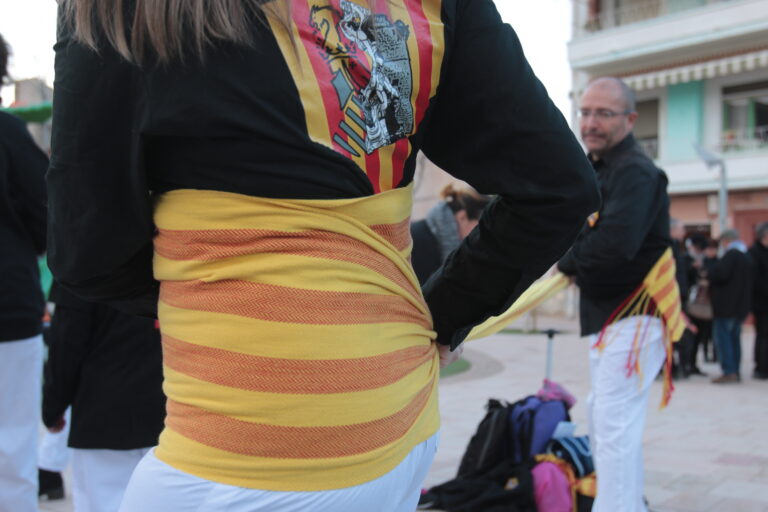9 d’Octubre
The Nou d’Octubre celebrates the anniversary of the conquest of the city of Valencia by King Jaume I in 1238, which led to the creation of the kingdom of Valencia. It is one of the oldest festivals of foundation of kingdoms still existing today, a fact that is due to its adaptation to the constant socio-political changes that have occurred in the Valencian territory throughout history.
In Sant Joan d’Alacant the festival began to be celebrated from the transition with some cultural or vindictive acts by some neighbors, cultural associations and political groups. Since then, as it is a public holiday, there have been markets of local commerce and handicrafts, typical Valencian dances, popular lunches, parades and concerts of music in Valencian. One of the most anticipated events of this date is the presentation of the Llibre del Nou d’Octubre on local themes, an edition that began in 1997 with a monograph on the Queens and Ladies of the feasts of Christ and that each year, dedicates its pages to deal with the history, customs and experiences of characters santjoaners.


Did you know that...?
The creation of the Kingdom of Valencia was due to an initiative of King Jaume I who thus avoided the susceptibilities of Catalans and Aragonese who had participated in the conquest of this territory from the Muslims, and who sought to take control of the new lands. The new kingdom, endowed with its own laws and institutions, was thus inhabited mainly by Catalans, Aragonese and numerous Muslims who continued to live in the Kingdom until the expulsion of the Moors was decreed in 1609. This cultural diversity led to the existence of various languages, religions and socioeconomic relations throughout the territory. One of the most notorious features would be the Aragonese linguistic predominance in the interior and Catalan on the coast, which in this case would receive the proper name of Valencian.
At first the kingdom covered south to Xixona-Biar, as established in the Treaty of Almizrra of 1245 between the crowns of Castile and Aragon, so that Alicante was within the Castilian territory, but in the late thirteenth century, King James II exceeded this border reaching Murcia. After a hard confrontation with the Crown of Castile, finally the new demarcations were established with the signing of the treaties of Elche and the Sentence of Torrellas, incorporating in 1305 to the Kingdom of Valencia the territories up to Orihuela, leaving Alicante and therefore its Huerta with Sant Joan and Benimagrell at the head within the Kingdom of Valencia.

The kingdom of Valencia maintained its own political personality until the Nueva Planta Decrees of 1714, which suppressed Valencian laws and institutions, as happened in Aragon, the Balearic Islands and Catalonia, replaced from that moment by Castilian ones, in retaliation for having supported the territories of the Crown of Aragon during the War of Succession to the Habsburgs instead of the Bourbons, the victors in the conflict. The date on which the Austracist defeat was consummated in the battle of Almansa, on April 25, 1707, provoked the beginning of the reprisals and was immortalized in the collective memory as a nefarious fact in the saying: ‘quan el mal ve d’Almansa, a tots alcança’ (when evil comes from Almansa, it reaches everyone). April 25 is currently commemorated by several cultural and political groups, and by the Valencian Parliament, which celebrates its day on this date.

Premi 9 d’Octubre XXII Edició 2016 collected by the members of the Lloixa Cultural Association for its 35 years of life and commitment to the santjoaner culture.
The Kingdom of Valencia formally disappeared in the 18th century, although this term was maintained in historiography, chronicles and popular memory together with País Valenciano, both referring to a mainly geographical and cultural affiliation, until the transition to self-government was recovered and the denomination of Comunidad Valenciana was created and adopted.
The statute included the official Valencian symbols: the flag with the arms of the crown of Aragon, with red and yellow stripes or bars and the crown on a blue stripe; the coat of arms of King Pere IV the Ceremonious with the Aragonese arms and helmet with dragon; and the anthem composed in the early twentieth century by Serrano and Thous. Other groups also claim the music of the dance of the Muixeranga d’Algemesí, declared a World Heritage Site, as a Valencian anthem.
King Jaume I (1208-1276) is considered one of the most important medieval characters representing the chivalric values of faith, courage and honor. The story of his life is surrounded by a halo of mystery, feats and exploits that mix reality and legend. To him is attributed the work of the ‘Llibre dels Fet’, which narrates his life and works. In Sant Joan d’Alacant, an important avenue was dedicated to him in 1983, replacing the name of General Mola that until then he had held.
There is a curious legend that places the passage of the king by a farmhouse of Sant Joan d’Alacant during his stay in the Huerta de Alicante; grateful to the monarch for the excellent treatment received by its inhabitants decided to grant them the tax exemption, so that the house was known since then as the Hisenda d’El Franc i el de Soler, farmhouse located on the traditional path of the Embarcadero to the beach. The chronicler of Sant Joan, Isidro Buades, dedicated a nice poem to this legend entitled: ‘El Rei en Jaume Primer en el Franc i el de Soler’.
